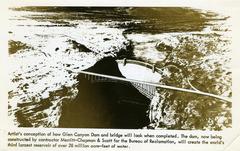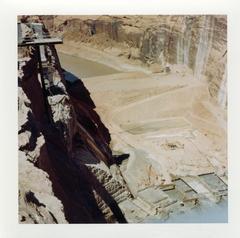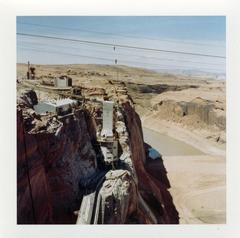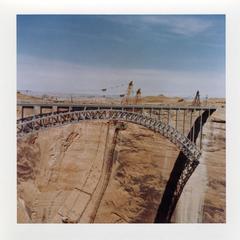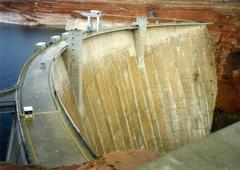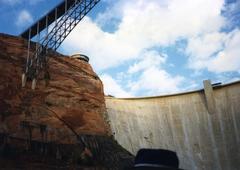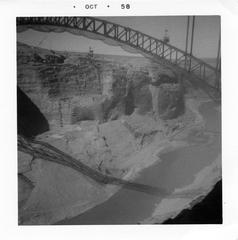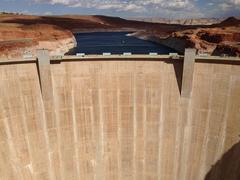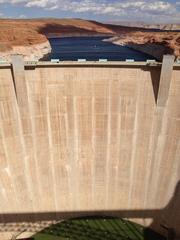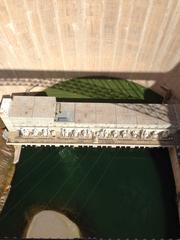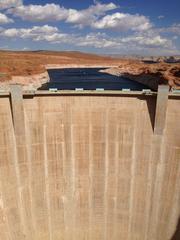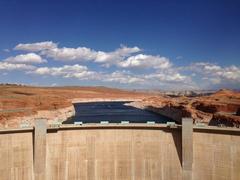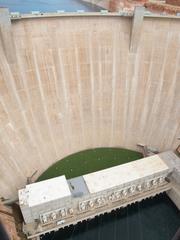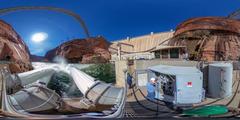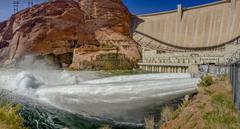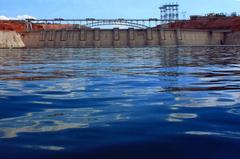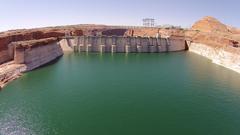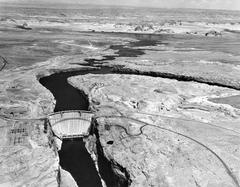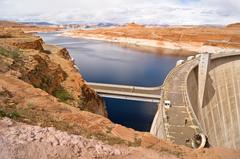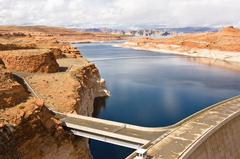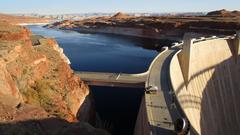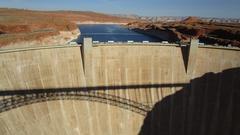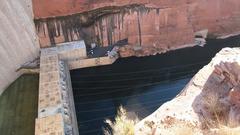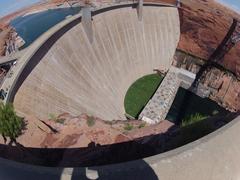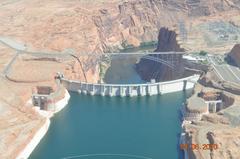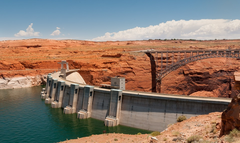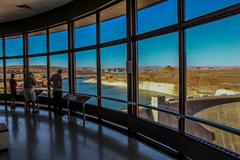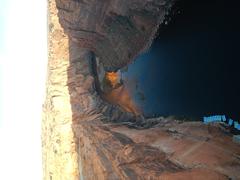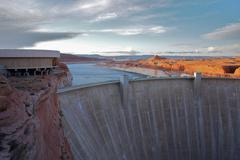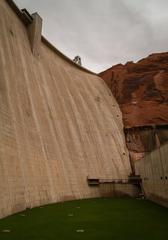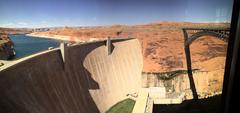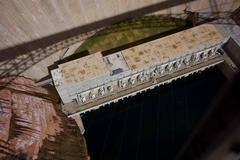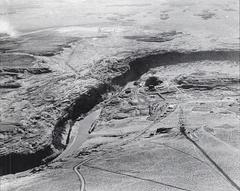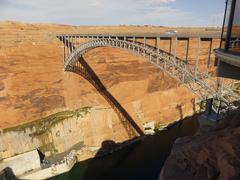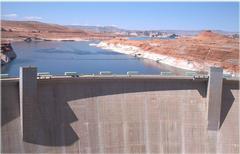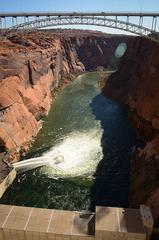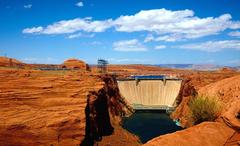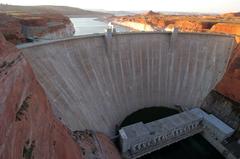
Visiting Glen Canyon Dam Bridge: Hours, Tickets, and Historical Insights
Date: 20/07/2024
Introduction
The Glen Canyon Dam Bridge, located in Marble Canyon, Arizona, is a marvel of modern engineering and a significant landmark in the American Southwest. Constructed as part of the Glen Canyon Dam project, this bridge has played a pivotal role in the region’s development since its completion in 1959. Spanning 1,271 feet across the Colorado River and standing 700 feet above the riverbed, the bridge was an essential component for transporting materials and workers during the dam’s construction. Today, it remains a testament to mid-20th-century engineering prowess (U.S. Bureau of Reclamation) (National Park Service) (American Society of Civil Engineers).
The Glen Canyon Dam itself, which began operations in 1963, has had a profound impact on water storage, flood control, and hydroelectric power generation in the southwestern United States. The dam created Lake Powell, one of the largest man-made reservoirs in the country, which has become a major recreational area attracting millions of visitors annually. However, the construction of the dam and bridge has not been without controversy, as it led to the flooding of Glen Canyon and the loss of numerous archaeological sites, sparking ongoing debates about environmental conservation and resource management (Lake Powell Resorts & Marinas) (U.S. Department of Energy) (Glen Canyon Institute).
This comprehensive guide aims to provide visitors with all the essential information needed for a memorable trip to Glen Canyon Dam Bridge, including its history, significance, visiting hours, ticket information, and travel tips. Whether you are interested in the engineering feats, the breathtaking views, or the recreational opportunities, this guide will help you make the most of your visit.
Table of Contents
- Introduction
- History and Significance of Glen Canyon Dam Bridge
- Visitor Experience
- Preservation Efforts
- Conclusion
- FAQ
History and Significance of Glen Canyon Dam Bridge
Historical Background
The Glen Canyon Dam Bridge, located in Marble Canyon, Arizona, is an engineering marvel that has played a crucial role in the development of the American Southwest. The bridge was constructed as part of the Glen Canyon Dam project, which began in the 1950s. The dam itself was authorized by the Colorado River Storage Project Act of 1956, aimed at providing water storage, flood control, and hydroelectric power to the region (U.S. Bureau of Reclamation).
The construction of the Glen Canyon Dam Bridge was necessitated by the need to transport materials and workers across the Colorado River during the building of the dam. The bridge was completed in 1959, three years before the dam was finished in 1963. At the time of its completion, it was one of the highest bridges in the world, standing 700 feet above the river (National Park Service).
Engineering Feats
The Glen Canyon Dam Bridge is a steel arch bridge, a design chosen for its strength and ability to span large distances without the need for numerous supports. The bridge spans 1,271 feet across the canyon and has a deck width of 40 feet. The construction of the bridge was a significant engineering challenge due to the remote location and the sheer drop of the canyon walls. Workers had to use innovative techniques, including the use of cableways to transport materials across the canyon (American Society of Civil Engineers).
Economic and Social Impact
The completion of the Glen Canyon Dam and its bridge had a profound impact on the region. The dam created Lake Powell, one of the largest man-made reservoirs in the United States, which has become a major recreational area attracting millions of visitors annually. The bridge itself has facilitated tourism and commerce in the region, providing a critical transportation link between northern Arizona and southern Utah (Lake Powell Resorts & Marinas).
The hydroelectric power generated by the dam has been a significant source of energy for the southwestern United States. The dam’s power plant has a capacity of 1,320 megawatts, providing electricity to approximately 5.8 million people. This has contributed to the economic development of the region, supporting industries and communities (U.S. Department of Energy).
Environmental and Cultural Significance
The construction of the Glen Canyon Dam and its bridge has not been without controversy. The damming of the Colorado River flooded the Glen Canyon, submerging numerous archaeological sites and altering the natural ecosystem. This has led to ongoing debates about the environmental impact of large-scale water projects and the preservation of natural and cultural resources (Glen Canyon Institute).
Despite these controversies, the Glen Canyon Dam Bridge remains a symbol of human ingenuity and the ability to overcome natural obstacles. It stands as a testament to the mid-20th century’s ambitious infrastructure projects that aimed to harness natural resources for human benefit.
Visitor Experience
Ticket Prices and Visiting Hours
The Glen Canyon Dam Bridge is accessible year-round, with the Carl Hayden Visitor Center open daily from 8:00 AM to 6:00 PM during the summer months and from 8:00 AM to 5:00 PM during the winter months. Entrance to the visitor center is free, but guided tours of the dam, which include a walk across the bridge, may require a ticket. It is advisable to check the official website for the most up-to-date information on ticket prices and availability (National Park Service).
Travel Tips and Nearby Attractions
When planning your visit to the Glen Canyon Dam Bridge, consider the following tips:
- Wear comfortable shoes: The area around the bridge and dam includes walking trails with varying terrain.
- Stay hydrated: The Arizona climate can be very hot, especially in the summer, so bring plenty of water.
- Plan for extra time: The visitor center and guided tours can take several hours to fully explore.
Nearby attractions include Antelope Canyon, Horseshoe Bend, and the Rainbow Bridge National Monument, all of which offer unique natural beauty and photographic opportunities.
Accessibility
The Glen Canyon Dam Bridge and the Carl Hayden Visitor Center are accessible to visitors with disabilities. There are designated parking spaces, ramps, and elevators to ensure that all visitors can enjoy the facilities.
Preservation Efforts
Efforts are ongoing to preserve the historical and environmental integrity of the Glen Canyon Dam and its bridge. The National Park Service and other organizations are working to balance the needs of water resource management with the preservation of natural and cultural resources. This includes monitoring the environmental impact of the dam and implementing measures to protect the surrounding ecosystem (National Park Service).
Conclusion
The Glen Canyon Dam Bridge stands as a remarkable symbol of human ingenuity and the transformative power of modern engineering. Since its completion in the late 1950s, the bridge has not only facilitated the construction of the Glen Canyon Dam but has also become an iconic tourist attraction in Marble Canyon, Arizona. The bridge’s role in creating Lake Powell and generating hydroelectric power has had lasting economic and social benefits for the region, although it has also brought to light important environmental and cultural considerations (National Park Service) (American Society of Civil Engineers) (Glen Canyon Institute).
Visiting the Glen Canyon Dam Bridge offers a unique opportunity to witness a significant piece of American infrastructure history while enjoying the stunning natural beauty of the area. From guided tours and educational exhibits at the Carl Hayden Visitor Center to the numerous recreational activities available at Lake Powell and the surrounding areas, there is something for everyone to enjoy. By following the tips and information provided in this guide, visitors can ensure a safe, informative, and enjoyable experience.
As efforts continue to preserve the historical and environmental integrity of the Glen Canyon area, it is important for visitors to practice responsible tourism. This includes adhering to Leave No Trace principles, respecting wildlife and natural habitats, and supporting ongoing conservation initiatives (National Park Service). For the latest updates and more information, download our mobile app Audiala, explore related posts on our website, or follow us on social media.
References
- U.S. Bureau of Reclamation, 2024, Glen Canyon Dam and Bridge https://www.usbr.gov/projects/index.php?id=142
- National Park Service, 2024, Glen Canyon Dam Bridge History https://www.nps.gov/glca/learn/historyculture/glen-canyon-dam.htm
- American Society of Civil Engineers, 2024, Glen Canyon Dam Bridge Project https://www.asce.org/project/glen-canyon-dam-bridge
- Lake Powell Resorts & Marinas, 2024, Lake Powell Overview https://www.lakepowell.com/
- U.S. Department of Energy, 2024, Hydroelectric Power at Glen Canyon Dam https://www.energy.gov/
- Glen Canyon Institute, 2024, Environmental Issues https://www.glencanyon.org/
- National Park Service, 2024, Carl Hayden Visitor Center https://www.nps.gov/glca/planyourvisit/carl-hayden-visitor-center.htm
- National Park Service, 2024, Glen Canyon National Recreation Area https://www.nps.gov/glca/index.htm
- National Park Service, 2024, Accessibility Information https://www.nps.gov/glca/planyourvisit/accessibility.htm
